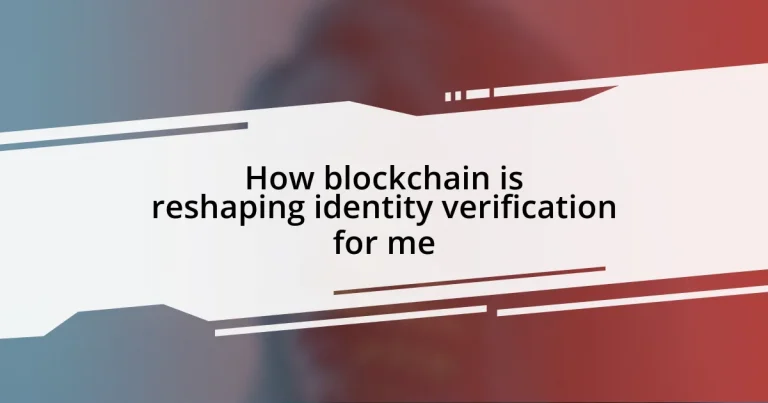Key takeaways:
- Blockchain technology provides a decentralized, tamper-proof method for identity verification, enhancing security and trust.
- Key benefits include immutable records, decentralization, and improved access to identity management without intermediaries.
- Current challenges include lack of standardization, data breaches, and poor user experience in traditional identity systems.
- Future trends may include biometric data integration and greater user control over personal data, alongside evolving regulations to protect users.
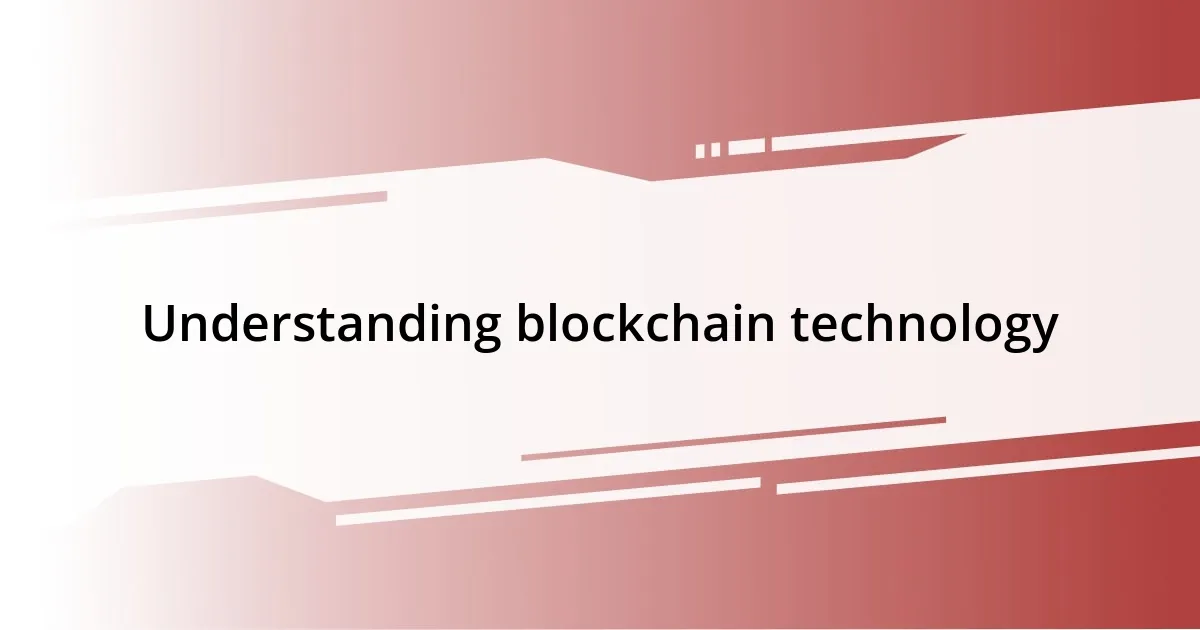
Understanding blockchain technology
Blockchain technology is essentially a decentralized digital ledger that records transactions across many computers, making it nearly impossible to alter or hack. When I first encountered the concept, I was amazed by its potential; the idea that every transaction is securely documented creates an unprecedented level of trust. Have you ever wondered how many of our daily activities would change if we eliminated central authorities?
At its core, blockchain operates through a series of blocks linked together, forming a chain—hence the name. Each block contains a set of transactions and is validated by network participants, a process that I find incredibly exciting because it democratizes trust. Think about the last time you had to wait for a third party to verify your identity—frustrating, right?
I recall a situation where I had to prove my identity for a time-sensitive application, and it was a truly nerve-wracking experience. Blockchain holds the promise to streamline such processes, allowing for real-time identity verification without the hassle of unnecessary intermediaries. Isn’t it intriguing to consider how this technology might not just reshape our identities but also enhance our sense of security in an increasingly digital world?
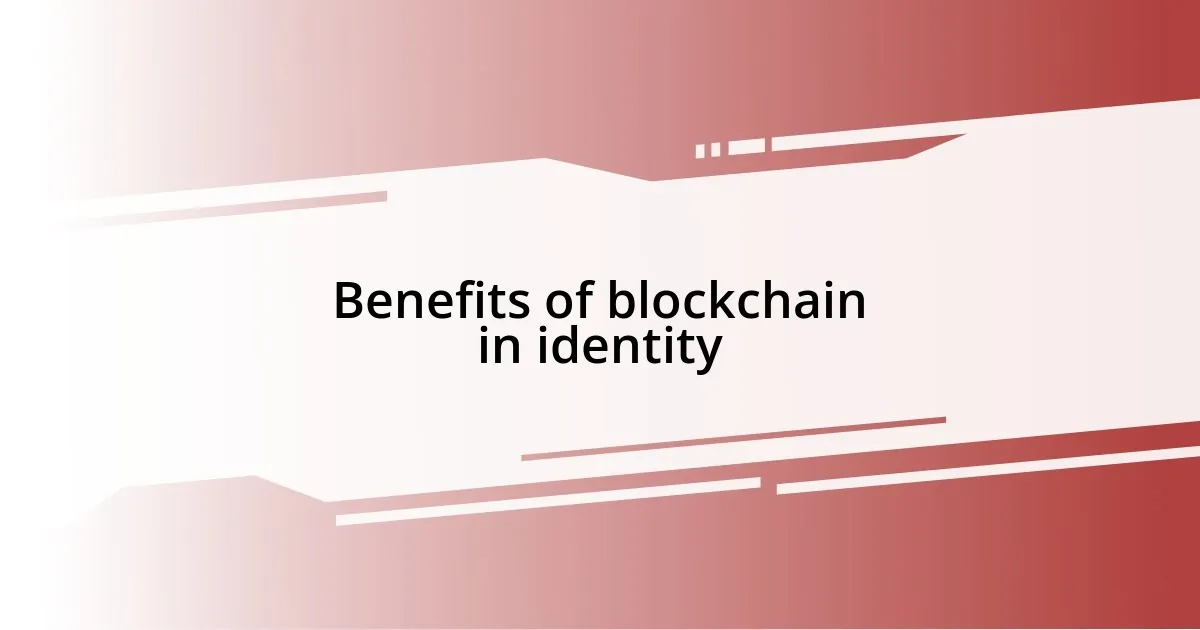
Benefits of blockchain in identity
The benefits of blockchain in identity verification are both significant and transformative. One of the most compelling advantages is the enhanced security it offers. With each identity credential recorded on a decentralized network, the chances of data breaches decrease dramatically. I remember a time when my personal information was compromised after a data leak, and the anxiety that followed was overwhelming. Knowing that blockchain can provide a more secure alternative feels like a game-changer.
Here are some key benefits to consider:
- Immutable Records: Once data is recorded on the blockchain, it cannot be changed or deleted, providing a permanent and tamper-proof record of identity.
- Decentralization: This eliminates single points of failure and reduces the dependency on centralized authorities, minimizing the risk of fraud.
- Improved Access: Individuals can manage their identity and credentials without needing intermediary validation, making processes like onboarding and verification faster.
In addition, the transparency of blockchain technology fosters trust among users. Having access to verifiable and reliable information is empowering. I think back to applying for a loan and the tedious requirements involved. Blockchain could ultimately streamline that process, cutting down on the time and stress typically associated with identity verification.
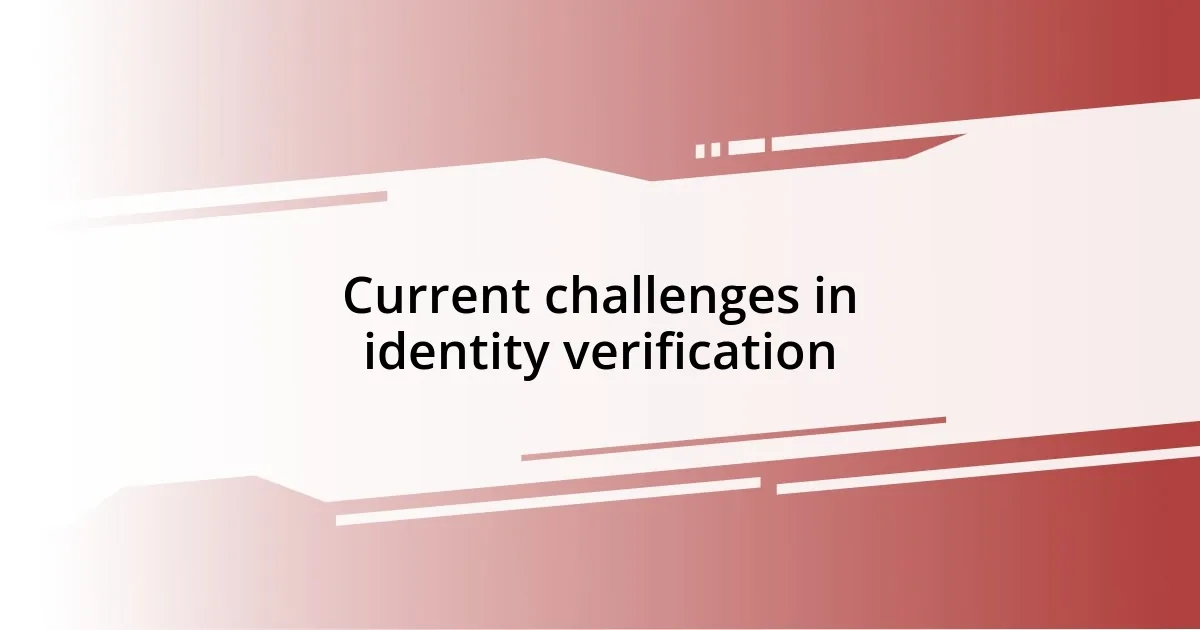
Current challenges in identity verification
Current challenges in identity verification are numerous and complex, often leading to frustration for individuals. One primary struggle is the lack of standardization across various systems. I’ve experienced this firsthand while trying to update my identification documents across different platforms. Each entity requests its own set of verification methods, which can feel like running in circles.
Another daunting challenge is the risk of data breaches. Just a few years ago, I found out that a major company I trusted had suffered a security breach, compromising countless users’ personal information, including my own. The anxiety and uncertainty that arose from that incident made me realize how fragile traditional identity verification systems can be. It’s fascinating (and a bit unsettling) to think that our identities can be stolen or misused so easily in today’s digital age.
Moreover, user experience often takes a backseat to security measures. I remember a recent attempt to verify my identity for a new banking app that felt overly complicated, almost discouraging. When systems prioritize overly strict protocols without considering usability, it creates an unnecessary barrier. It’s clear that there’s a need for innovative solutions to these challenges.
| Challenge | Description |
|---|---|
| Lack of Standardization | Different entities require various verification methods. |
| Data Breaches | Hackers compromise personal information, creating risk. |
| Poor User Experience | Overly complex verification processes deter users. |
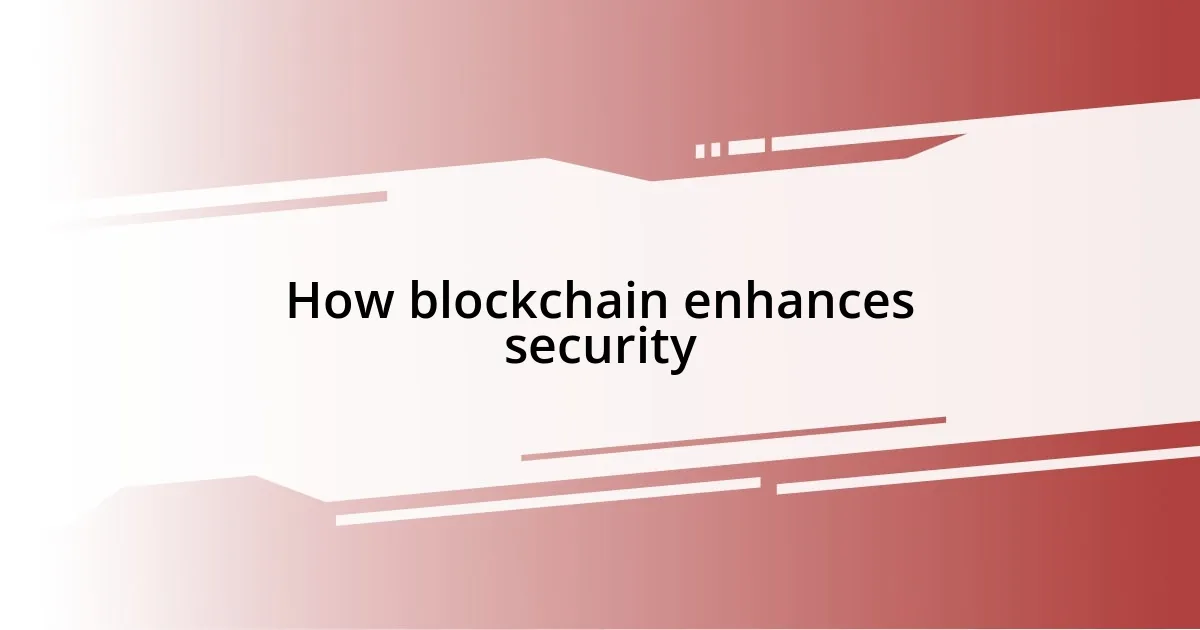
How blockchain enhances security
When I think about how blockchain enhances security, I can’t help but feel a sense of relief. Its immutability means that once my identity data is recorded, it’s set in stone. I remember once being so frustrated after finding out my personal data had been altered without my consent by a service I trusted, leaving me vulnerable. With blockchain, that fear vanishes, as the records can’t be changed or deleted, ensuring my identity remains safe from tampering.
Decentralization is another critical aspect that strengthens security. In my experience, relying on centralized systems has led to significant headaches. I can recall a time when a popular service experienced a total outage, rendering my account inaccessible. It made me acutely aware of the risks involved with putting my trust in a single entity. Blockchain’s decentralized nature means there’s no singular point of failure, making it much harder for fraudsters to exploit the system.
I often find myself pondering the future of identity verification in a world governed by blockchain. What if we could easily verify our identities with a simple scan of our phones, knowing that the information is encrypted and secure? That’s not just a far-off dream; it’s becoming a reality. The possibility of improved access to our identity data, securely managed by us, is exhilarating. It feels liberating to think about a future where I wouldn’t have to jump through hoops to prove who I am, all thanks to the security blockchain offers.
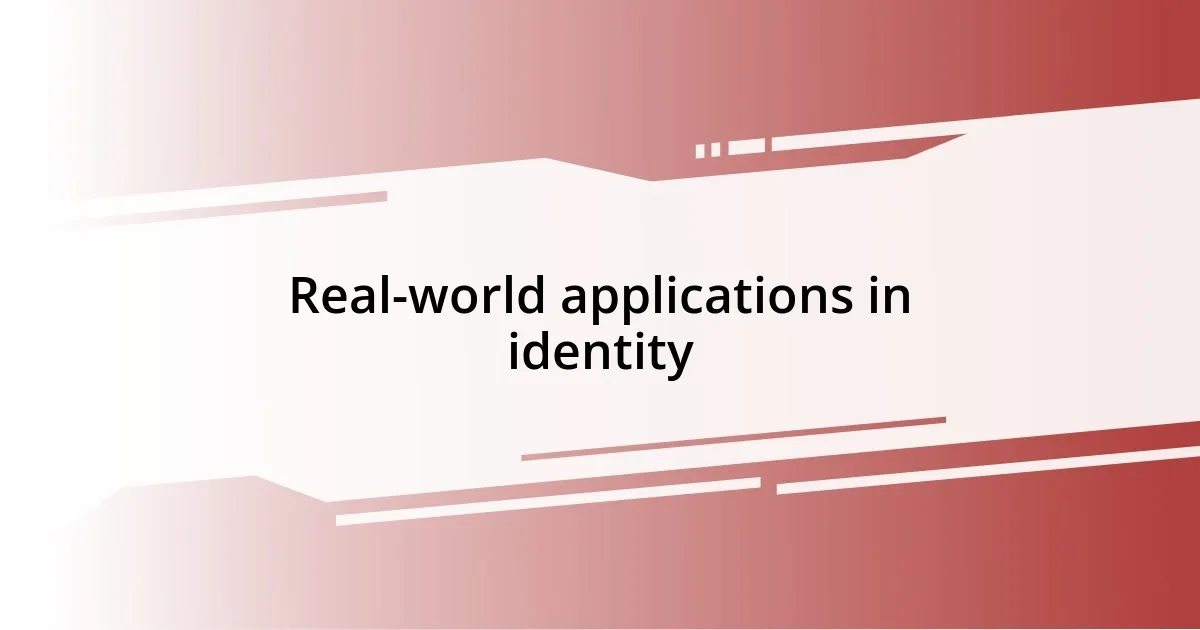
Real-world applications in identity
When I dive into the real-world applications of blockchain in identity verification, I can’t help but think about the potential convenience it brings. For example, while trying to pick up a package that required my ID, I was frustrated by the lengthy process. Imagine if I could simply authenticate myself using a blockchain-based digital ID on my phone—no waiting in line, no hassle. Personally, I can see how this seamless experience would not only save time but also enhance security.
Another area that excites me is how blockchain can empower individuals, particularly in underbanked communities. I once volunteered at a local nonprofit where many individuals lacked access to traditional banking services due to unreliable identification. With blockchain, people can create verified digital identities without needing a physical address or governmental recognition. It made me wonder—how many lives could this transform? The ease of access to services just by having a verifiable identity can foster a sense of belonging and inclusion in a world that often marginalizes the most vulnerable.
Moreover, I find it inspiring that companies in sectors like healthcare are adopting blockchain for identity verification. I’ve seen firsthand how tedious it can be to repeatedly share and verify my medical history with various providers. If my health records were linked to a blockchain identity, healthcare professionals could access the information securely, without the back-and-forth of paperwork. Wouldn’t it be refreshing to streamline this process? The prospect of transparency and efficiency in such a critical area of our lives feels monumental.
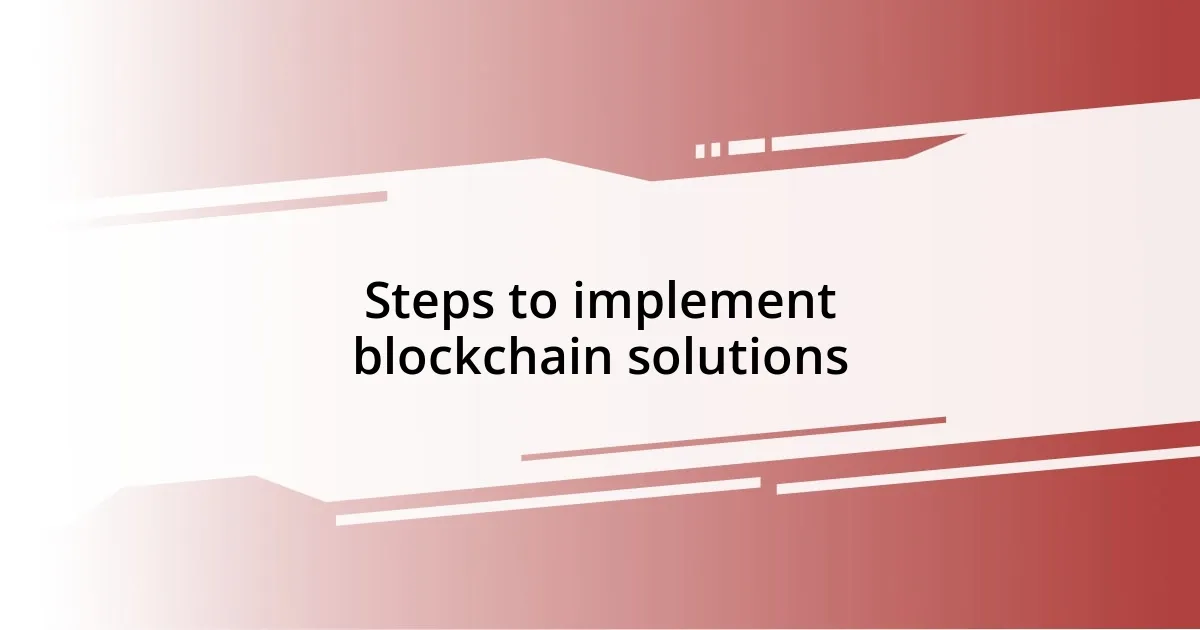
Steps to implement blockchain solutions
Implementing blockchain solutions doesn’t have to be overwhelming. First, it’s crucial to identify the specific use case you want to address, which involves gathering a clear understanding of the challenges you’re facing. I remember working with a small team where we spent hours discussing whether blockchain was truly necessary for our identity verification process. Clarifying our goals helped us decide on the best approach.
Once we had our use case nailed down, the next step was selecting a suitable blockchain platform. There are various options out there, each with unique features and benefits. I recall evaluating several solutions and being amazed at how different they could be in terms of speed and adaptability. There’s a lot to consider, but aligning with a platform that fits your needs will save you a lot of headaches down the road.
Following the platform selection, the actual development phase begins. This can be a daunting prospect, especially if you’re new to blockchain technology. When I participated in a project, we adopted an agile development approach, which allowed us to iterate quickly and adapt our solution based on continuous feedback. I found that regular collaboration not only fostered creativity but also helped build trust among team members. How might your projects benefit from a similar approach? It’s all about creating a work environment where everyone feels invested in the outcome.
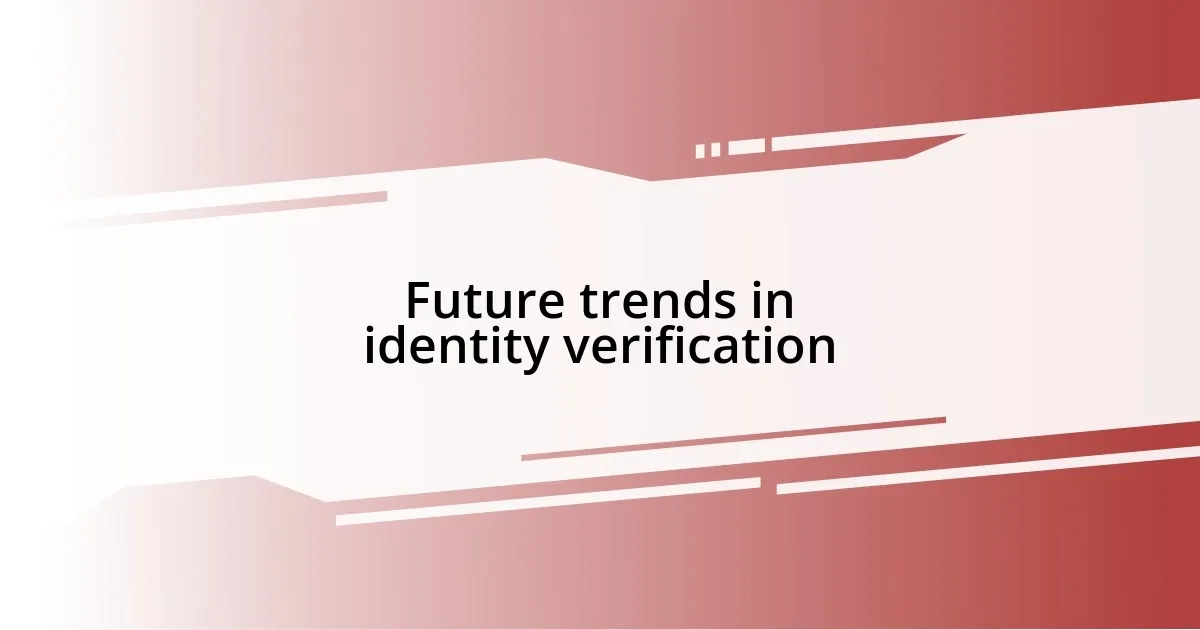
Future trends in identity verification
As I look ahead at the future of identity verification, I can’t help but envision the widespread use of biometric tools alongside blockchain technology. Just the other day, I marveled at how a simple fingerprint scan can unlock my phone—it’s almost like magic. Integrating biometric data with blockchain could enhance security even further, ensuring that only the rightful owner can access their identity. Wouldn’t it be incredible to see that level of personalization and safety in everyday transactions?
Another trend that captures my attention is the growing emphasis on user control over personal data. I remember a time when I felt uneasy sharing my information online, often wondering where it was stored and who had access. With blockchain, individuals can own and manage their digital identities, granting permission only when necessary. It’s a significant shift toward transparency and empowerment that could transform how we interact with online platforms. What if we could decide exactly what information to share and with whom? The possibilities are exciting.
Lastly, I can sense that regulatory bodies will play a crucial role in shaping the future of identity verification. Having once navigated the complex landscape of compliance for a startup, I understand how daunting it can be. Regulations around blockchain will likely evolve, ensuring that while we innovate, we also protect personal information. How can organizations balance innovation with compliance effectively? I believe finding that sweet spot will be key to fostering trust in this digital age.












